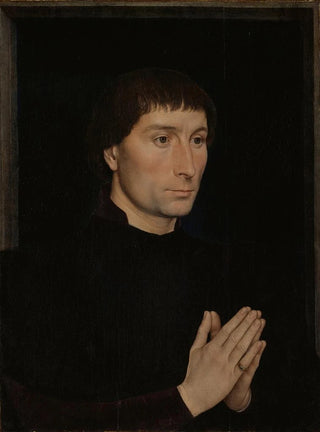Art print | Thomas de Folco Portinari 1428-1501 - Hans Memling Source: Reproduction | Thomas de Folco Portinari 1428-1501 - Hans Memling


View from behind

Frame (optional)
Thomas de Folco Portinari 1428-1501 - Hans Memling – Engaging Introduction
The art print of Thomas de Folco Portinari 1428-1501 - Hans Memling immerses us in the fascinating world of 15th-century Flemish painting. This iconic work, depicting a central figure of the Renaissance, is a poignant testament to the art of its time. By exploring this tableau, we discover not only the richness of Memling's pictorial technique but also the story of a man whose journey is intimately connected to the cultural and economic upheavals of his era. The representation of Thomas de Folco Portinari, an influential merchant and patron of the arts, invites reflection on the role of the individual in history and on how art can immortalize lives and stories.
Style and uniqueness of the work
Hans Memling's style is distinguished by remarkable finesse and particular attention to detail. In the art print of Thomas de Folco Portinari, each element is carefully studied, from the drapery of the clothing to the subtle expressions on the face. Light plays a crucial role in this piece, creating delicate shadows that bring the character to life. Memling uses a rich and nuanced color palette, where warm tones blend with darker shades, thus enhancing the emotional depth of the scene. This tableau does not merely depict an individual; it captures the very essence of its era, revealing the aspirations and concerns of a society in full transformation. The composition is balanced, with an architectural background that evokes the grandeur of the merchant cities of the period, while emphasizing Portinari's imposing stature. This work is a perfect example of how art can transcend simple portraiture to become a true visual narration.
The artist and his influence
Hans Memling is one of the undisputed masters of Flemish painting. Born around 1430, he established himself on the Bruges art scene, where he developed a unique style that influenced many contemporary and future artists. His ability to capture the psychology of characters, through facial expressions and postures, marked a turning point in human representation in painting. Memling also played a key role in the evolution of the portrait

Matte finish

View from behind

Frame (optional)
Thomas de Folco Portinari 1428-1501 - Hans Memling – Engaging Introduction
The art print of Thomas de Folco Portinari 1428-1501 - Hans Memling immerses us in the fascinating world of 15th-century Flemish painting. This iconic work, depicting a central figure of the Renaissance, is a poignant testament to the art of its time. By exploring this tableau, we discover not only the richness of Memling's pictorial technique but also the story of a man whose journey is intimately connected to the cultural and economic upheavals of his era. The representation of Thomas de Folco Portinari, an influential merchant and patron of the arts, invites reflection on the role of the individual in history and on how art can immortalize lives and stories.
Style and uniqueness of the work
Hans Memling's style is distinguished by remarkable finesse and particular attention to detail. In the art print of Thomas de Folco Portinari, each element is carefully studied, from the drapery of the clothing to the subtle expressions on the face. Light plays a crucial role in this piece, creating delicate shadows that bring the character to life. Memling uses a rich and nuanced color palette, where warm tones blend with darker shades, thus enhancing the emotional depth of the scene. This tableau does not merely depict an individual; it captures the very essence of its era, revealing the aspirations and concerns of a society in full transformation. The composition is balanced, with an architectural background that evokes the grandeur of the merchant cities of the period, while emphasizing Portinari's imposing stature. This work is a perfect example of how art can transcend simple portraiture to become a true visual narration.
The artist and his influence
Hans Memling is one of the undisputed masters of Flemish painting. Born around 1430, he established himself on the Bruges art scene, where he developed a unique style that influenced many contemporary and future artists. His ability to capture the psychology of characters, through facial expressions and postures, marked a turning point in human representation in painting. Memling also played a key role in the evolution of the portrait






